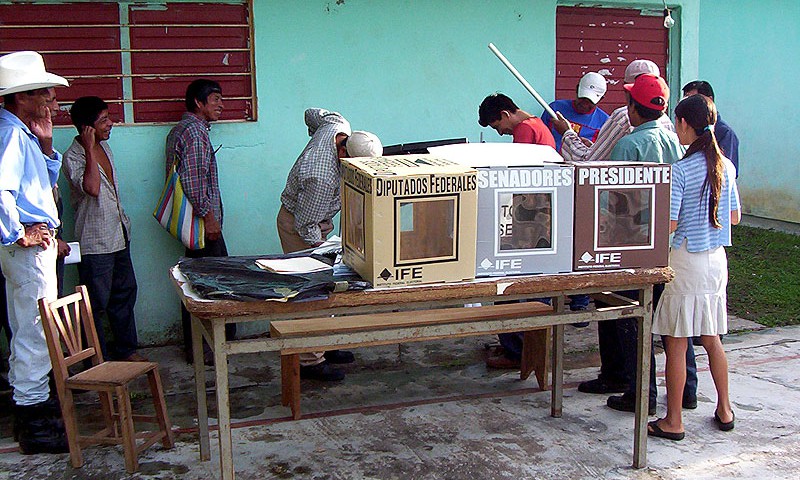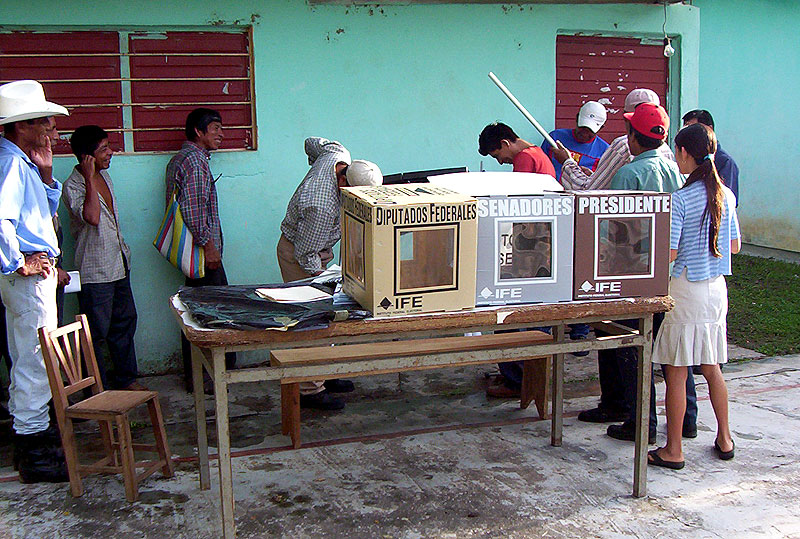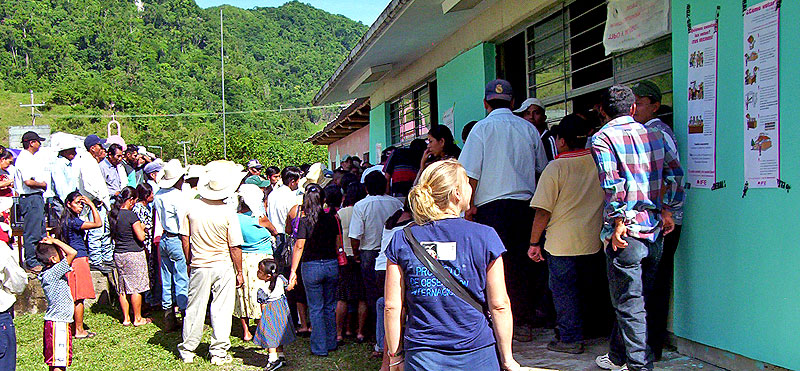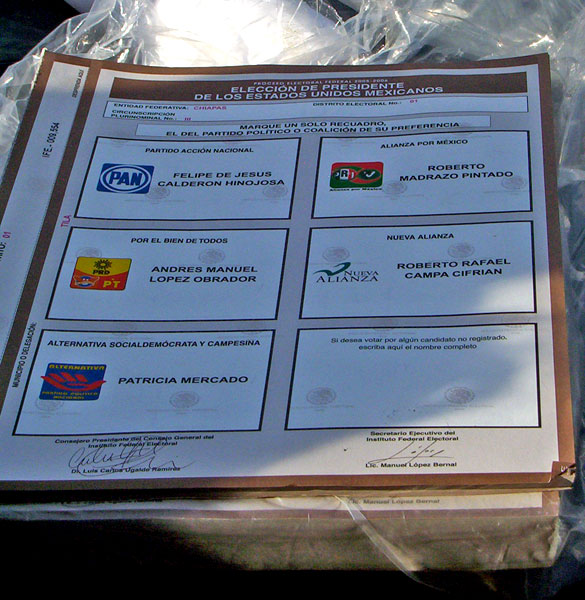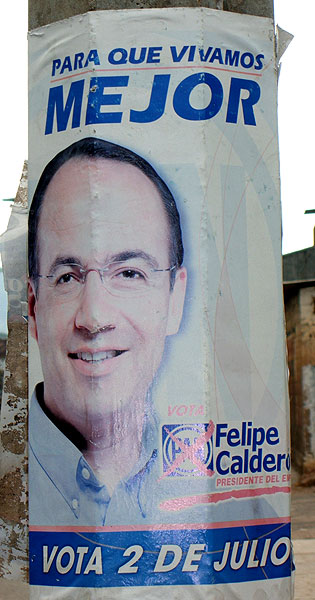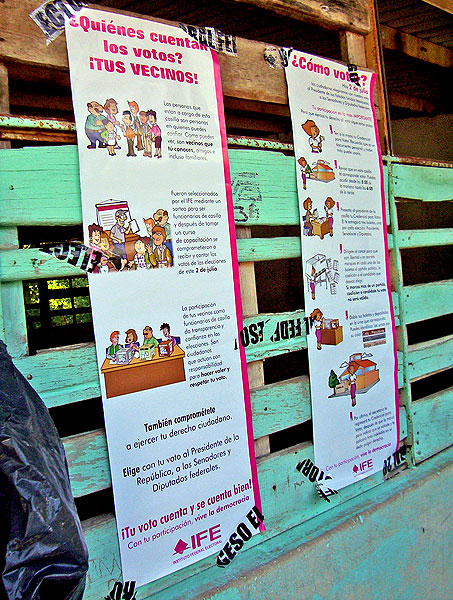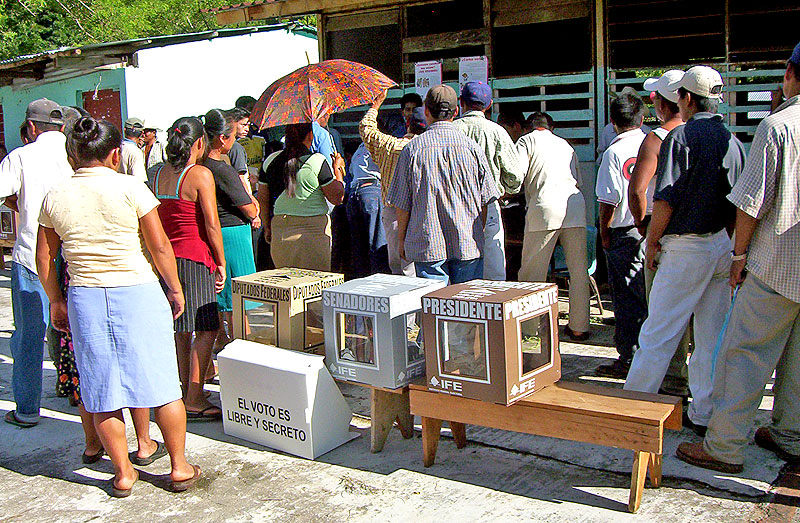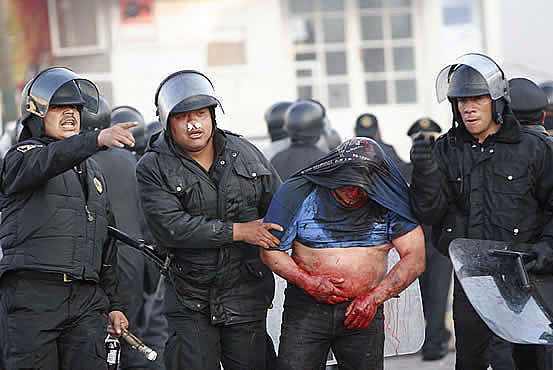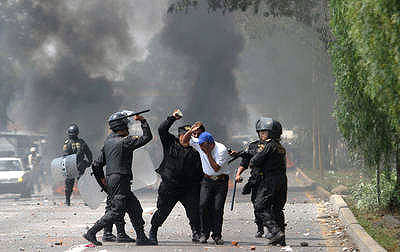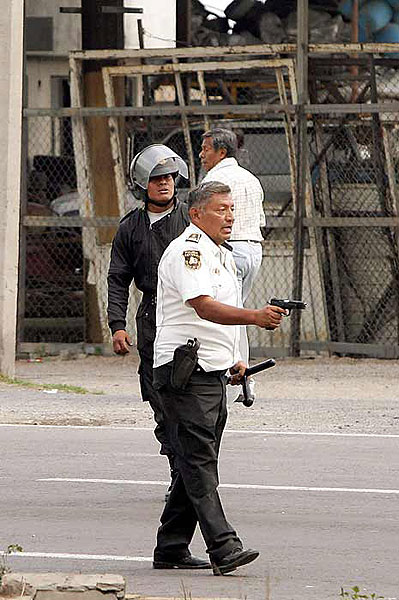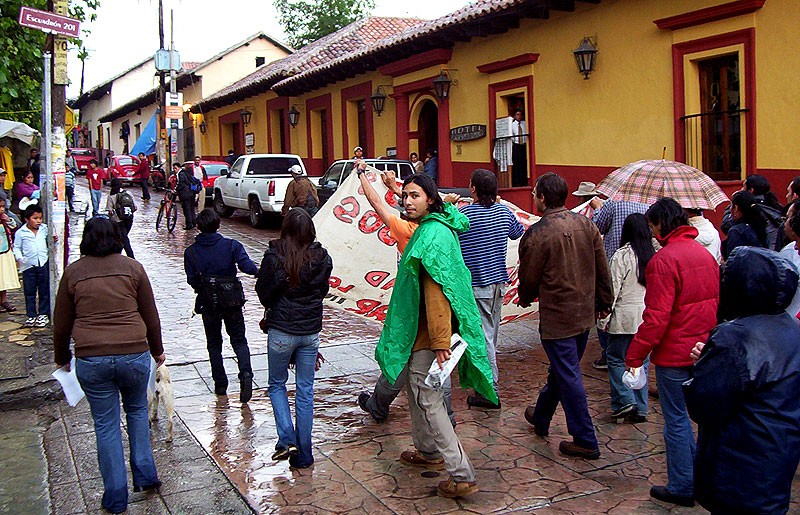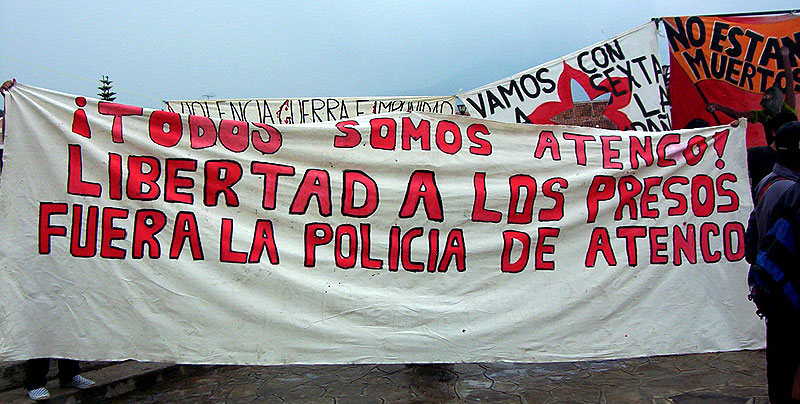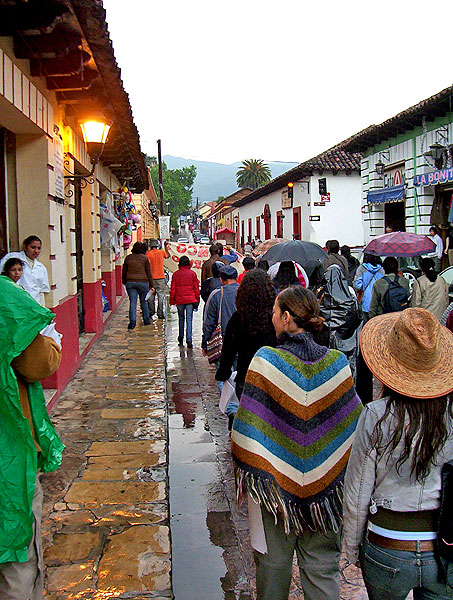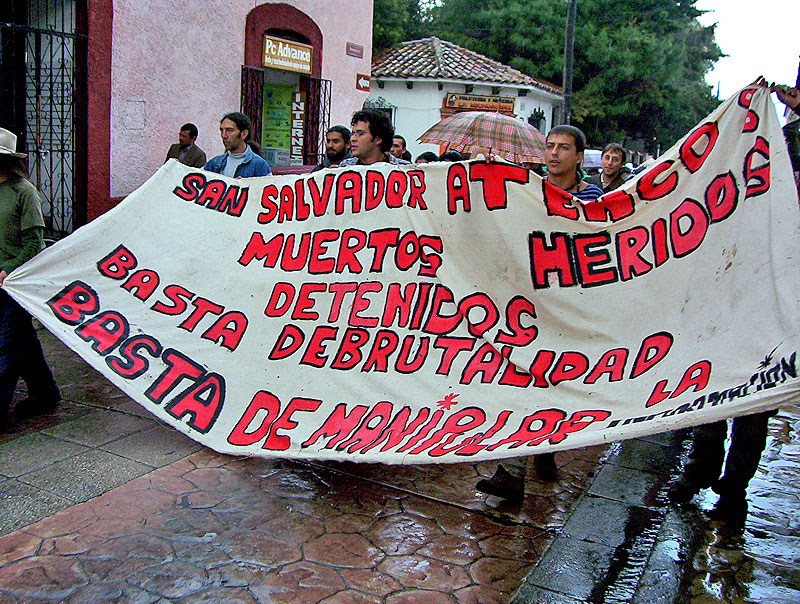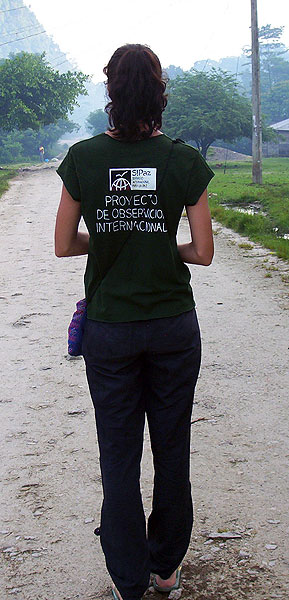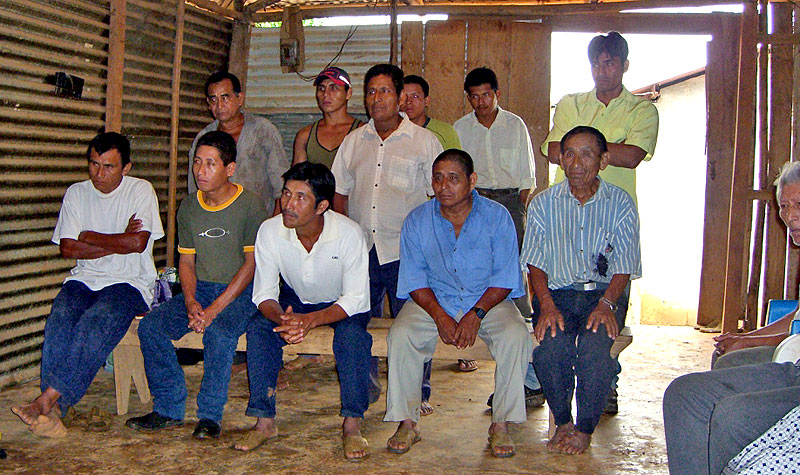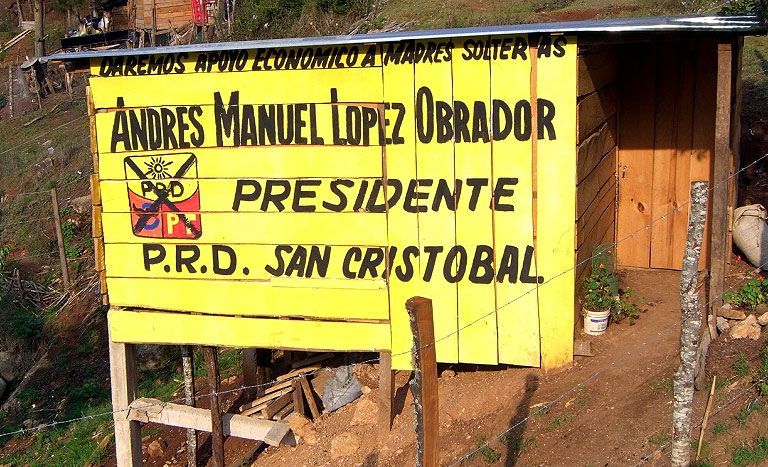SIPAZ Activities (January 15 – March 2006)
28/04/2006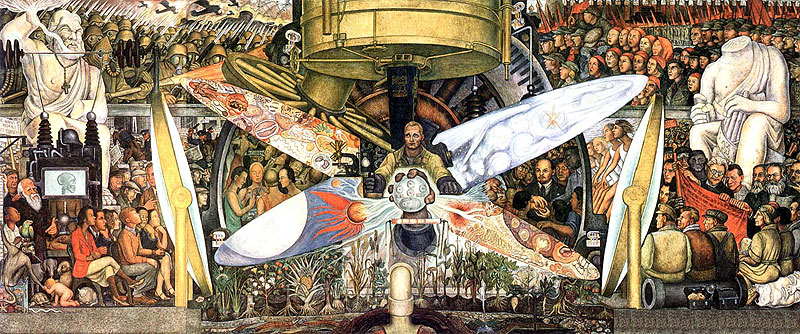
UPDATE : Mexico – Two presidents?
30/11/2006On July 2nd, federal elections were held in Mexico. That night, the Federal Electoral Institute (IFE)- the agency responsible for the counting of votes- declared itself incapable of announcing a winner because of the minimal margin between the two leading candidates and postponed the announcement of the results. All the same, that night, both Andrés Manuel López Obrador (AMLO, the candidate for the Alliance for the Good of All, which includes various center and left parties: Democratic Revolution Party, PRD; Workers’ Party, PT; and Convergence) and Felipe Calderón (National Action Party, PAN, right) declared themselves the winners. In the following days, a district by district count was conducted and legal challenges were brought to the Electoral Tribunal of Judicial Power of the Federation (TEPJF). This agency must resolve the legal challenges by August 31st and September 6th is the final day to declare the new president elect.
An Incomplete Electoral Proces
Election day itself was relatively calm. 99.4% of the polling places were successfully set-up (130,407 of the 130,488 planned), which is the highest level in Mexico’s electoral history. Nearly 60% of Mexican voters participated (the abstention level was 41% as compared to 36% in the 2000 elections). At 8 p.m., the president of the IFE, Luis Carlos Ugalde, described Election Day 2006 as “exemplary and successful.” He affirmed that the 3,047 reported “incidents” (particularly in the installation of polling places) did not affect the results of the election.
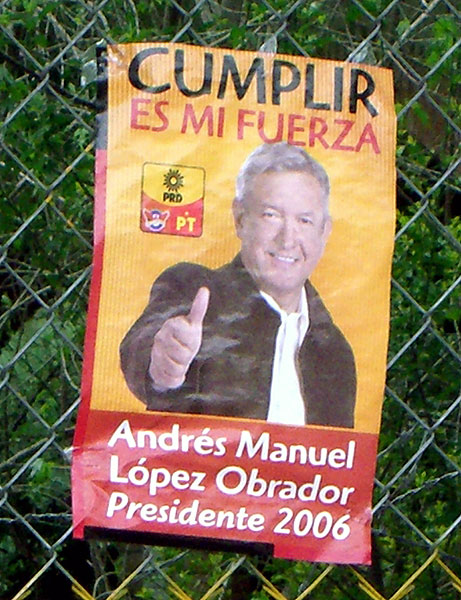 In the hours that followed, the figures indicated a “technical tie” with a slim advantage for Calderón over López Obrador. AMLO denounced a discrepancy of nearly three million missing votes. The following day, the IFE stated that this was explained by the more than eleven thousand ballot boxes that were not included in the first count because they presented “inconsistencies.” When the IFE did include these votes, the margin between Calderón and AMLO reduced to 0.64%. The third candidate for the presidency, Roberto Madrazo Pintado (of the Alliance for Mexico which includes the Institutional Revolution Party, PRI, and the Ecological Green Party of Mexico, PVEM) immediately acknowledged his defeat.
In the hours that followed, the figures indicated a “technical tie” with a slim advantage for Calderón over López Obrador. AMLO denounced a discrepancy of nearly three million missing votes. The following day, the IFE stated that this was explained by the more than eleven thousand ballot boxes that were not included in the first count because they presented “inconsistencies.” When the IFE did include these votes, the margin between Calderón and AMLO reduced to 0.64%. The third candidate for the presidency, Roberto Madrazo Pintado (of the Alliance for Mexico which includes the Institutional Revolution Party, PRI, and the Ecological Green Party of Mexico, PVEM) immediately acknowledged his defeat.
Legally, the next step was the count of the ballot boxes that corresponded to the 300 electoral districts. The IFE conducted this count from Wednesday July 5th to Thursday July 6th. Unlike in the first count, from the beginning AMLO maintained a lead over Calderón, though the margin became smaller and smaller until Calderón surpassed him reaching a final lead of 0.58%. Once he was in the lead, in the early hours of the morning, Calderón made a statement for national reconciliation. The morning of Thursday the 6th, with 400 polling places still to be counted, AMLO announced that he would legally challenge the results before the TEPJF: “The apparatus and resources continue to be used by the State to favor the candidate from the right (…) it is obvious that the PREP (Preliminary Electoral Results Program which does the first rapid count for the IFE) was manipulated. There has been little transparency. The IFE lacks independence. There were orders that the ballot boxes not be opened and an unusual hurry to resolve, in less than 24 hours, a numerically tight election. We can not recognize the results. There are many inconsistencies, irregularities. We are going to challenge the election and demand that the ballot boxes be opened and that there be a vote by vote count.” On the 7th, Luis Carlos Ugalde, IFE president, declared Felipe Calderón the winner.
In the days that followed the Alliance for the Good of All submitted more than 300 pieces of support before the TEPJF. This reflected irregularities in about 50,000 of the more than 130,000 polling places set-up. The PAN and its candidate have opposed the opening of the ballot boxes and the counting of the more than 41 million votes casted. Both sides have called for peaceful social demonstrations.
The TEPJF, which it is important to recall ruled in favor of the PAN in the case of the television ads against AMLO, has the legal ability to declare the electoral process invalid if they deem it necessary. The results of the election remain pending until August 31st, the deadline for resolving the legal challenges.
First Assessments Awaiting Definite Results
Regardless of which of the two presidential candidates is declared the winner, AMLO or Calderón, they will have been elected by only one fifth of the votes, the most minimal margin in the history of Mexican presidential elections. The fact that there were close to 14 million votes for each of the two leading candidates would suggest an ongoing situation of division and a high risk of social conflict both in the short and long term.
Another aspect of this election was the polarization between the North (mainly PAN supporters) and the South (majority AMLO supporters) of Mexico. It is also important to highlight that in the elections on July 2nd, the PRD won in Mexico City, maintaining control of the post of mayor of the Federal District for the third straight election.
The federal elections for congressional representatives resulted in the election of a Congress that will be strongly divided. Whichever of the two candidates ends up winning the elections will have to do so without a parliamentary majority. If Calderón wins (his party would have the largest minority in Congress with 206 of the 500 deputies and 52 senators),. But he would have to deal with an adverse and resentful portion of the opposition. If AMLO were to become the president , his party, the Alliance for the Good of All, has won only 160 deputies and 36 senators seats.
The PRI only received 21% of the votes for president, even being defeated in its historic bastions of Oaxaca and Chiapas. In comparison with the presidential election of 2000, the PRI lost 5 million votes, transforming it into the third national political force. Nevertheless, having won 121 deputies and 39 senators at the Congressional level the PRI could still play an important role in the necessary alliances and political negotiations between the represented parties.
Finally, it is worth mentioning that the New Alliance Party (Nueva Alianza) surprisingly won 9 deputies and 1 senator, while the Socio-Democratic Alternative Party won 4 deputies.
The Impact of a Turbulent Pre-Electoral Context
The way that the electoral campaigns were carried out (reaching the point of personal disqualifications between the candidates) will surely complicate the post-electoral situation. While some observers and electoral experts reject the possibility of cybernetic fraud or old-fashioned ballot box fraud, there have been many reports of induced voting and many electoral violations in the months before the election, intensifying in the final days of June. This fact was illustrated by the results of the Monitoring of Social Programs, carried out in 22 states of Mexico by 25 NGOs, coordinated by Alianza Cívica, A.C. and Global Exchange (USA). This initiative examined how various federal social programs were being used for the conditioning and buying of votes, in this case in favor of the PAN.
As a matter of fact, in May, both the PRI and the PRD denounced that a genuine “election by the state” was happening, with the presidency being used to support the PAN candidate. Roberto Madrazo even called on the PRD to form a formal alliance to oppose this “election by the state.”
On June 6th, during the second debate between the presidential candidates, AMLO denounced the trafficking of influences and fiscal evasion by Diego Hildebrando Zavala, Calderón’s brother-in-law. Subsequent research by journalists revealed to the public the fact that through the use of his own computer science enterprises Zavala had direct and complete access to lists of the beneficiaries of the main federal social assistance programs, as well as to the Electoral List and the Preliminary Electoral Results Program (PREP).
Various sectors began to question the impartiality of the IFE in its role as a neutral arbitrator, given its minimal responses to the aforementioned issues. Weeks before the election, various analysts began to denounce the possibility of cybernetic fraud.
In June, at the same time that the majority of polls were showing a lead for AMLO, an intense television ad campaign was initiated, sponsored by the Coordinating Council of Businesses (CCE, Consejo Coordinador Empresarial). This ad campaign stigmatized AMLO as a “danger” for Mexico and induced a “vote of fear” in favor of Calderón. In other news, in the past months, the divisions in the PRI leadership intensified to the point that associated PRI members were openly calling on PRI support bases to carry out a “practical vote,” given Roberto Madrazo’s minimal chances of winning the election. Some called for supporting AMLO, while others for supporting the PAN.
A Vote of Fear in a Heated Social Context? The multimillion peso ad campaign sponsored by the CEE also coincided with a moment of great social tension. In the months leading up to the elections, there were a series of violent incidents in various parts of the country.
In May, the case of Atenco was definitely the most talked about issue (see: www.sipaz.org). On May 3rd, a conflict emerged between 8 mobile flower vendors and the police in the city of Texcoco (State of Mexico) because of the PRD mayor’s prohibition of their vending in an area already designated for the construction of a Wal-Mart store. This conflict resulted in a violent confrontation. The result of the two brutal police operatives that followed were two deaths (a teenager on the same day, and another young man, in June, as a result of being hit in the head with a teargas grenade), several injuries, 211 arrests, and 5 deportations of foreigners. More than 20 women were sexually assaulted and 7 raped by state security forces while being transported to jail.
Currently, 28 of the 211 arrested remain in jail on serious charges (kidnapping of public officials). 146 of the arrested were released on bail ($814,125 pesos per person). The National Human Rights Commission (CNDH) received more than 150 reports of various forms of violence.
In June, the teachers’ movement in Oaxaca mobilized more than 40,000 teachers in a sit-in that was supported by broad social sectors of the state. It began with union demands (rezoning of salaries), but grew to incorporate and even prioritize a call for the resignation of the PRI governor Ulises Ruíz, a figure considered, by most of the social organizations of the state, to be very repressive. A police operative, meant to expel the sit-in, was resisted and rejected by the protesting teachers, who then cut off dialogues with the Ministry of the Interior and threatened to boycott the federal elections. There were no major problems on Election Day, and the PRI was defeated.
In Chiapas, at the beginning of May, the state government ordered two police operatives to dislodge the sit-ins set up by those affected by Hurricane Stan in Escuintla and Motozintla, where the civil population protested the government’s failure to fulfill its promises and the delays in the reinforcement of the river banks. On May 8th, there was another operative carried out in Bochil (Highlands) to dislodge the municipal presidency, which had been occupied for over a month, protesting acts of corruption committed by the municipal president. According to figures from the Fray Bartolomé de Las Casas Human Rights Center, the results of this repressive operative were dozens of injuries and 64 arrests.
The Other Campaign: Post-Atenco Changes
The political process initiated by the Zapatista Army for National Liberation (EZLN) one year ago, suffered changes as a result of the conflict in Atenco. The same day of the conflict, Delegate Zero (Subcomandante Marcos) suspended the national tour and stated his intention to stay in Mexico City until all of the political prisoners are released. At that same moment, a Red Alert was declared in all of the Autonomous Municipalities and Good Government Councils (Juntas de Buen Gobierno) in Chiapas. Marcos opened himself to the commercial mainstream media and participated in a series of mobilizations and meetings with different social sectors. There were also local demonstrations held in a number of Mexican states. In May, there were also two major meetings: the Fourth National Indigenous Congress (CNI) was held in the State of Mexico, with 800 representatives from 31 different indigenous groups from 25 states, and the National Conference for the dissemination of strategies for Legal Defense, with 30 NGOs from 17 Mexican states participating.
Nevertheless, priority was given to freeing those detained in Atenco. On May 28th, at the National March for the Liberation of the Prisoners and for Justice for the Raped Women of Atenco, held in Mexico City, Subcomandante Marcos stated “for the Zapatistas, the Other Campaign has moved on to the organizational phase. While there are some important issues relating to the definition of its profile that remain pending, the Other Campaign is now responding as a national organization (in the 32 states), with ethics (not leaving the prisoners to their own luck), high morals (superimposing itself on the terror that the government attempted to implant in Atenco), and with the ability to create autonomous and independent mobilizations (separate, concentrated mobilizations).” Depending on the source, the number of participants at this demonstration varies between seven thousand and fifty thousand people.
The next day, in a national meeting of adherents to the Other Campaign, Marcos called for “a national concentration to peacefully and civilly impact the electoral process,” on July 2nd. This was questioned by some intellectuals and analysts as an action that would favor the interests of the extreme right.
In other news, there have been reports that the judicial processes against those detained in the two operatives and the incorporation of previous investigations regarding the cases of rape against female detainees have been the subject of multiple delays, obstacles, and corruption. On the other side of the situation, only 23 low ranking police officers have been held on minimal charges, and they were immediately released on bail.
At the international level, the outcry from the Other Campaign, regarding the repression and human rights violations in Atenco, has had greater impact. Along with the national demonstrations, 124 actions were carried out in 52 cities of 24 countries, in protest of the violence in Atenco and in response to the call made by the Intergalactic Commission of the Other Campaign.
International human rights organizations such as Amnesty International and Human Rights Watch issued reports on the issue. The Civil Commission of International Human Rights Observation (CCOIDH), which met in Mexico from May 29- June 4th, released a preliminary report of the violation of the rights of the civil population of Atenco: “the police operative included the excessive use of force, opposite to the principles of proportionality, reasonability, and absolute necessity that should guide it.” The report affirms that all the high-ranking police should be fired and that all the detainees be freed, based on their presumed innocence.
State Elections: Ruptures and Party Changes
The federal elections (primarily for president) have overshadowed the state electoral process in which the next governor of Chiapas will be decided on August 20th. The announcement of the candidates and alliances was marked by tensions, ruptures, and party changes. The registered candidates are:
- Juan Sabines for the PRD/Convergence (until the end of April 2006, he was the municipal president of the capital of Chiapas, Tuxtla Gutiérrez, for the PRI party). Antonio Aguilar Bodegas for the PRI/PVEM (former Senator, see the April 2006 SIPAZ Report).
- Francisco Rojas Toledo for the PAN (federal deputy, former mayor of Tuxtla form 2001-2004, and former candidate for senator).
- Gilberto Gómez Maza for the Socio-Democratic Alternative Party (founder of the PRD in Chiapas, he resigned from the party in 2002 in protest of the internal breakdown and the control that the current governor, Pablo Salazar Mendiguchía, exercised over the PRD State Committee).
- Emilio Zebadúa for the New Alliance Party (PANAL) (former civil advisor for the IFE, former Secretary of State for Chiapas and former federal deputy for the PRD, he started his campaign with support from mainly indigenous PRD supporters, in the Highlands and Selva regions).
These appointments and the ruptures they implied for the parties as well as for the voters suggest a high level of abstentionism (it generally fluctuates between 60-70%). In particular, this is likely to be true for the population of the large area affected by Hurricane Stan last year (41 municipalities total, 26 which were severely affected), with the rainy season in full swing, it will be physically and emotionally difficult to travel to the polling places to vote. (see the report “The Area Affected by Stan: Social and Electoral Tensions”)
The impact of the federal electoral process on the state context remains unknown. Another significant political occurrence has been the PRD candidate, Juan Sabines’s signing of the “Declaration of Comitán,” the proposed Development Plan for the state. This document was developed and publicly presented by Roberto Albores Guillén (former PRI governor and former precandidate for the state election) who is supported by a large sector of the voters. Sabines publicly promised to incorporate the proposals of this Declaration into his Government Plan.
According to various analysts, this Plan presents neoliberal characteristics. For example, the construction of a broad network of highways and freeways, the creation of a “new Cancún in northern Chiapas” and the establishment of a irrigation system with agroindustrial objectives in the Soconusco and Coast areas. On the other hand, the Plan also includes counterinsurgency actions, including the creation of new constitutional municipalities, most of which would be superimposed on autonomous Zapatista municipalities.

